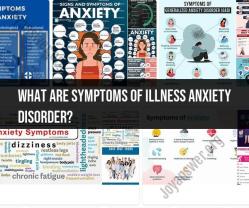What are the characteristics of generalized anxiety disorder?
Generalized Anxiety Disorder (GAD) is a common mental health condition characterized by excessive, persistent, and uncontrollable worry and anxiety about various aspects of life, even when there is little or no apparent reason for concern. The symptoms of GAD can be both physical and psychological. To receive a diagnosis of GAD, these characteristics and symptoms typically persist for at least six months and significantly interfere with daily functioning. Here are the key characteristics and signs of Generalized Anxiety Disorder:
Excessive Worry: Individuals with GAD often worry excessively about a wide range of everyday concerns, including health, finances, work, relationships, and more. This worry is often disproportionate to the actual situation or threat.
Inability to Control Worry: People with GAD find it challenging to control or stop their worrying, even when they recognize that it's excessive or irrational. Attempts to stop worrying may be unsuccessful.
Restlessness and Irritability: Individuals with GAD may feel restless, on edge, or keyed up. They may become easily agitated and irritable.
Physical Symptoms: GAD can manifest physically, leading to symptoms such as muscle tension, headaches, trembling, sweating, and stomachaches. These physical symptoms can sometimes be misinterpreted as signs of a medical condition.
Fatigue: Chronic worry and anxiety can lead to persistent fatigue and a sense of being worn out, both mentally and physically.
Difficulty Concentrating: People with GAD often have difficulty focusing or concentrating on tasks because their minds are preoccupied with worry.
Sleep Disturbances: Sleep problems, including difficulty falling asleep, staying asleep, or experiencing restless sleep, are common among individuals with GAD.
Exaggerated Anxiety Response: Individuals with GAD may experience an exaggerated anxiety response to everyday stressors. They tend to anticipate negative outcomes and overestimate the likelihood of catastrophic events.
Muscle Tension: Persistent muscle tension, often felt as aches or soreness, is a common physical symptom of GAD.
Physical Health Concerns: People with GAD may frequently worry about their physical health, even when there is no evidence of illness. This can lead to excessive doctor visits and medical tests.
Avoidance Behavior: In an attempt to reduce anxiety, individuals with GAD may avoid situations or activities that trigger their worry or anxiety. This can lead to social and occupational impairment.
Perfectionism: GAD is often associated with a tendency toward perfectionism and high standards for oneself.
Anticipatory Anxiety: GAD often involves anticipatory anxiety, where individuals worry about future events or situations, even if they are not imminent.
Physical and Psychological Distress: The persistent symptoms of GAD can lead to significant distress, impair daily functioning, and negatively impact relationships, work, and overall quality of life.
It's important to note that GAD is a treatable condition. If you or someone you know is experiencing these characteristics and symptoms, it is advisable to seek help from a mental health professional. Effective treatments for GAD may include psychotherapy (such as cognitive-behavioral therapy) and, in some cases, medication prescribed by a healthcare provider. Early intervention can lead to better management and improved quality of life for individuals with GAD.
Recognizing Generalized Anxiety Disorder: Key Characteristics
Generalized anxiety disorder (GAD) is a common mental health disorder that causes excessive worry about a variety of things. People with GAD may worry about their health, their finances, their relationships, or work. They may also worry about things that are unlikely to happen, such as getting into a car accident or getting sick.
Some key characteristics of generalized anxiety disorder include:
- Excessive worry: People with GAD worry excessively about a variety of things, even when there is no real reason to worry.
- Difficulty controlling worry: People with GAD find it difficult to control their worry. They may worry even when they know that there is nothing they can do to change the situation.
- Unrealistic worry: People with GAD may worry about things that are unlikely to happen.
- Physical symptoms of anxiety: People with GAD may experience physical symptoms of anxiety, such as restlessness, fatigue, difficulty concentrating, muscle tension, and sleep problems.
Living with GAD: Understanding the Traits of Generalized Anxiety Disorder
Generalized anxiety disorder can have a significant impact on a person's life. It can make it difficult to concentrate at work, to maintain relationships, and to enjoy life.
People with GAD may develop certain traits in order to cope with their anxiety. For example, they may avoid situations that make them anxious, or they may try to control everything in their life. However, these coping mechanisms can actually make the anxiety worse in the long run.
Generalized Anxiety Disorder: Common Characteristics and Symptoms
The common characteristics and symptoms of generalized anxiety disorder include:
- Excessive worry about a variety of things: People with GAD worry about a variety of things, such as their health, their finances, their relationships, or work.
- Difficulty controlling worry: People with GAD find it difficult to control their worry. They may worry even when they know that there is nothing they can do to change the situation.
- Unrealistic worry: People with GAD may worry about things that are unlikely to happen.
- Physical symptoms of anxiety: People with GAD may experience physical symptoms of anxiety, such as restlessness, fatigue, difficulty concentrating, muscle tension, and sleep problems.
Other common characteristics and symptoms of GAD include:
- Feeling on edge or keyed up
- Being easily startled
- Having trouble relaxing
- Having headaches, stomachaches, or muscle aches
- Having trouble sleeping
- Irritability
- Difficulty concentrating
- Feeling like your mind is going blank
- Feeling like you need to avoid certain situations or people
If you are experiencing any of these symptoms, it is important to talk to your doctor or a mental health professional. Generalized anxiety disorder is a treatable condition, and there are a number of effective treatments available.













